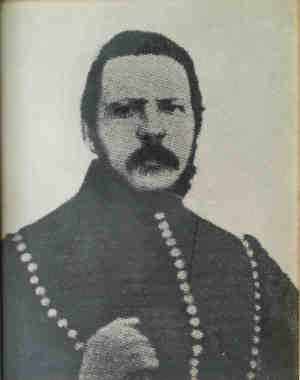Brigadegeneral Edvard Emil Langberg
- Født: 18 Maj 1810, København
- Død: 4 Sep. 1866, Sonora, Mexico i en alder af 56 år
 Dødsårsag: skudt. Dødsårsag: skudt.

 Notater: Notater:
Fra Texas State Historical Association:
LANGBERG, EDVARD EMIL (1810-1866). Edvard Emil (Emilio) Langberg, officer in the Mexican army, one of six children of Knud Engelbreth and Birgette (Jacobsen) Langberg, was born at Copenhagen, Denmark, on May 16, 1810. He came from a prominent family and was well educated; in addition, he was an accomplished violinist and a good horseman. He also studied law briefly. At the invitation of his brother Ludvig, who was living in Mexico, he immigrated in 1835 via Hamburg and New Orleans to Matamoros, Mexico. That year he joined Gen. Antonio López de Santa Anna's army, but he did not participate in the Texas campaign. In 1837 he was appointed a professor at the military academy in Mexico City and as the commander of the student company. He rose to second in command of the academy in 1838, was promoted to captain in 1839, lieutenant colonel in 1841, colonel in 1846, and brigadier general in 1856.
During the Mexican War he served as a cavalry officer under Gen. Gabriel Valencia in Tula and in Victoria, Tamaulipas. Under Gen . José de Urrea he participated in successful guerrilla attacks upon American forces at Marín (near Monterrey), Agua Negra, and Cerralvo, in Nuevo León. These campaigns were to disrupt American supply lines and assist Santa Anna's movement against Gen. Zachary Taylor in 1847. Near Mexico City Langberg fought in battles at Contreras and Churubusco; he was decorated for his service fighting the Americans.
In 1849 Langberg was appointed subinspector of the military colonies in Chihuahua. During that time he provided an escort for the American and Mexican parties surveying the new international boundary, made reports on the status of the military colonies, and made a reconnaissance of the Big Bend area on a trip from San Carlos, Chihuahua, to Monclova el Viejo, Coahuila, Mexico (on the Rio Grande). He also fought several Indian battles; the one at Laguna de Jaco against the Comanches was the most notable. He led Chihuahuan forces opposing efforts by New Mexico governor Henry Carr Lane to take control of the Mesilla area in New Mexico. During his service in Chihuahua he had contacts with American officers at Fort Filmore, New Mexico, and at El Paso, Texas, and worked with officials trying to stop contraband trade and filibustering on the frontier. He resigned in 1854.
On April 19, 1855, in New Orleans, Louisiana, he married Elizabeth Seraphine Trepagnier, daughter of Laurent and Louise Reine Trepagnier. The Langbergs had no children. He did have an illegitimate daughter, Helene Maria de la Luz, with Agustina Pareda. In 1855 he returned to Coahuila from New Orleans and was involved in recruiting support against Santa Anna, handling Indian problems, and dealing with the efforts of Texas filibusterers to apprehend runaway slaves in Mexico. He served as the military commandant of Coahuila (1855) and the state of Mexico (1857); he was appointed by Emperor Maximilian to the same position in Sonora (1865). He was also appointed military governor of the state of Mexico in 1857, and possibly held the same post in Coahuila for a very short time in 1855. He supported President Ignacio Comonfort and the liberal cause in 1856 and 1857, but when the conservatives triumphed he was allowed to go to New Orleans. In 1859 he returned to Mexico supporting the liberals, though he was not on good terms with Benito Juárez. In 1860 he was in Chihuahua briefly and then in Sonora. At the beginning of the French intervention he was in Mazatlán, Sinaloa, training troops and supporting the liberal regime. In the spring of 1863 he led to Mexico City troops who fought in the second battle at Puebla in May; he was ill, however, and did not participate in the defeat. Disillusioned, he resigned, submitting to the French occupation. In 1864 he was recruited by the French and was appointed military commandant of Sonora in 1865.
He was admitted as an honorary member to the prestigious Sociedad Mexicana de Geografía y Estadística, and the maps of the Chihuahua, Coahuila, and Texas frontiers executed by his engineers are presently in the cartographic collection of that society in Mexico City. Nominally he was a Lutheran and on one occasion chose to give up his fiancée rather than convert to Catholicism. Politically he was a liberal and sided with those of that view when possible, but during his military career he frequently served under reactionary generals. When he joined the French during the intervention, he expressed the idealistic view that a moderate constitutional monarchy would emerge and that conservatives would not hold power. He was shot and died in a battle with Republican forces at Guadalupe, Sonora, near Ures, on September 4, 1866.
Dr. Harry P. Hewitt
 Medicinske notater: Medicinske notater:
|



